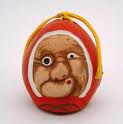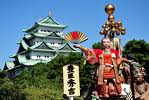[ . BACK to WORLDKIGO TOP . ]:::::::::::::::::::::::::::::::::::::::::::::::::::::::::::::::::::::::::::::::::::::::::::::::::::
Mie Prefecture Autumn Festivals:::::::::::::::::::::::::::::::::::::::::::::::::::::::::::::::::::::::::::::::::::::::::::::::::::
Autumn is the season of harvest. City festivals, which were originally traditions and ceremonies used to thank for the year's harvest, will be held in various towns. Enjoy autumn festival with singing and dancing. Until Nov. 7 OSHIRO MATSURI at Ueno
Castle, Iga-shi. A special exhibition of the
inside of the castle along with an exhibition
of seasonal flowers, including
chrysanthemums, is being held. There are
many events. Call: Ueno-jo 0595-21-3148
Sept. 30 & Oct. 1 SOHEI MATSURI
(Monk Soldiers Festival) at Yunoyama
Onsen. Kaen Mikoshi, portable shrines with
46 blazing torches, will be carried by fifty
people dressed in ancient monk soldier's
costumes. The highlight is the dynamic
sound of drums. This festival is in
conjunction with a memorial service for the
monk who discovered a hot spring in this
area (Yunoyama hot spring). Komono-cho,
Mie-gun. Call: Yunoyama Onsen Kyokai
059-392-2115
Sept. 30 & Oct. 1 ISOBE MATSURI
(Town Festival) around the Town Hall,
Isobe-cho, Shima-shi. Local products will
be sold and interesting performances are
performed. Call: 0599-55-3607
.................................................................................
Oct. 2 HANA NO IWAYA OTSUNAKAKE SHINJI at Hana no Iwaya Shrine in Kumano-shi.
花の窟神社秋季大祭(お綱かけ神事)
はなのいわやじんじゃしゅうきたいさい(おつなかけしんじ)
This unique rope ceremony is held twice a year in Feb. and Oct. A giant rope is suspended from a really big rock (45 m high), which forms an object of worship. The main deity is Izanami no Mikoto イザナミノミコト
10:00 - 11:30 A.M.
. . . CLICK here for Photos ! .................................................................................
Oct. 5 MANGAN DARUMA KUYO SAIat Kosai-ji Temple (also known as Darumadera Temple), Suzuka-shi.
memorial service for "Daruma tumbler dolls" that were used for making wishes last year and whose wishes were granted in 2005 is held.
.................................................................................
Oct. 5 MISHIODEN-SAI (Salt Ceremony)
at Mishioden Shrine, Futami-cho, Ise-shi.
Held for five days to pray for the safety of
the people who produce salt at Mishioden
Shrine in Futami-cho and also for the
development of the salt industry. Salt, a
vital food of life, has been thought to be an
important offering for the gods and
goddesses since ancient days. Salt has been
made in Futami-cho since ancient times, and
is used for cooking and is offered to the gods
and goddesses at the Grand Shrine of Ise.
This salt is also used to purify worshippers at
each ceremony. Call: Jingu Shicho 0596-24-
1111
Oct. 7 AWABI-OKOKU MATSURI
(Abalone Festival) around Wagu gyoko.
9:00 A.M. - 3:00 P.M. Call: Awabi-okoku
Matsuri Jikko Iinkai 0599-85-1114
Oct. 7 ISE SANJO SHUKI DAI ESHIKI
at Ibuta-ji Temple, Matsusaka-shi. Call:
0598-35-0004
Oct. 8 USHI MATSURI (Beef Barbecue
Festival) at Riverside Chakura, Matsusakashi.
Enjoy Matsusaka Beef. Reservation
Necessary. Call: 0598-32-3223
Oct. 9 KATTE JINJA REITAISAI at
Katte Shrine, Iga-shi. Kakko Odori (drum
dance), a cultural treasure of Mie Prefecture,
will be performed. Call: Iga-shi 0595-45-
Oct. 9 KITABATAKE SHRINE
OHMATSURI Many night stalls will be
open. Oct. 13 Ceremony at Kitabatake
Shrine, Misugi-cho, Tsu-shi. This festival
has the atmosphere of the Muromachi
Period. Call: 059-275-0615
Oct. 12 BASHOSAI at Ueno Park, Iga-shi.
A memorial service in honor of Matsuo Basho's
great achievement. He was the most famous
Haiku Poet in Japan. Call: Bunka Kokusaika
0595-22-9624
Oct. 13 - 18 MIEKEN NO KANKO TO
DAIBUSSANKAI (Sales Of Special
Products in Mie) at the Yokkaichi Store of
Chubu Kintetsu Department. Food,
handicrafts and pearl accessories will be
displayed and sold. Call: Mie-ken Bussan
Shinko-kai 059-213-0700
Oct. 14 HISAI MATSURI around Hisai
Office. 10:00 A.M. - 7:30 P.M. Many
products will be sold. A costume contest
will be held. Call: 059-255-3110
Oct. 14 SUZUNONE-ICHI (Bell Sound
Festival) around Matsusaka Station,
Matsusaka-shi. This exhibition is connected
with Motoori Norinaga, a scholar from the
Edo Period. Call: Matsusaka-shi Shoko
Kanko-ka 0598-53-4406
Oct. 14 KAMEYAMA AOZORA OCHA
MATSURI (Tea Leaves Festival) at
Nakano-yama Pilot, Kameyama-shi. You
can experience harvesting tea leaves. An
outdoor tea ceremony and a photo contest
are also held. Call: Kameyama Aozora Ocha
Matsuri Jikko Iinkai 0595-84-5082
Oct. 14 KANMISO-SAI (Garment
Ceremony) on May and October 14th, the
Kanmiso-sai or garment ceremony is held
every year. This ceremony is for the
seasonal change of clothing for gods and
goddesses. Silk and hemp are offered to the
gods and goddesses of Ise Jingu. These silk
and hemp garments are woven from the 1st
through the 13th of May and October at the
Kan-hatori-hatadono Shrine (silk) and the
Kan-omi-hatadono Shrine (hemp) in
Matsusaka which are both affiliated with Ise
Jingu. Call: 0596-24-1111
Oct. 14 EEJANKA MATSURI (Town
Festival) at Ago-cho, Shima-shi. Call: Agocho
Shoko Kanko Kankyo-ka 0599-43-0711
Oct. 14 & 15 THE 5th TOBA
HANDICRAFTS EXHIBITION & SALE
at Toba Shimin-no-mori Park, Toba-shi.
Craftsmen from all over Japan will gather at
Toba to exhibit and sale their works. Call:
Toba-shi Kanko Kyokai 0599-25-3019
Oct. 15 SEKIFUNE MATSURI at Kihokucho.
This festival goes back to the Edo
Period to pray for a bountiful harvest and
marine safety. 40 men dressed in white
kimonos will carry a "sekifune" or ship,
which kept pirates under tight control, on
their shoulders and march bravely in the
town. Call: Miyama-cho Suisan Shoko-ka
0597-32-1111
Oct. 15 - 17
KANNAMESAI The most
important ceremony at Ise Jingu. First fruits
are offered to the Great Sun Goddess.
Ohmatsuri, the city festival of Ise, used to
take place during this period. Call: Jingu
Shicho 0596-24-1111
Oct. 21 & 22 AUSTRALIA FAIR IN
YOKKAICHI at Australia Memorial Hall,
Yokkaichi. 10:00 A.M. - 4:00 P.M.
Oroducts, nature and sightseeing will be
introduced. A 10 minute walk from JR
Tomita Station. Call: Australia Fair in
Yokkaichi Jikko Iinkai 059-354-8176
Oct. 21 & 22 2006 BELLFARM
HARVEST FESTIVAL at Bellfarm,
Matsusaka-shi. Special products and slow
food will be sold. You can experience
pounding rice cakes and eating them. Call:
Bellfarm 0598-63-0050
Oct. 22 SHOKO MATSURI at Chuo
Oroshiuri Ichiba, Mikumo-cho, Matsusakashi.
The main attractions are a character
show (Kamen Rider), a quiz, and a street
performance. Call: Mikumo-cho Shoko-ka
0598-56-2039
Oct. 22 SHINJU MATSURI (Pearl
Thanksgiving Festival) at Kashikojima
Harbor, Ago-cho, Shima-shi. A parade of
rafts featuring a giant pearl will be exhibited
in Ago Bay. Call: Shinmei Shinju Yoshoku
Gyogyo Kyodo Kumiai Ago-cho Shoko
Kanko-ka 0599-43-1010
Oct. 27 - 29 ISE YOIYANA (Candle Lit
Festival) at Oharai-machi, Ise-shi. 500
candles will be lit along Oharai-machi in
front of the Grand Shrine of Ise. Call: Iseshi
Kanko Seisaku-ka 0596-21-5566
Oct. 28 SAIKU ROMAN MATSURI at
Itsukinomiya Historical Hall, Meiwa-cho,
Traditional art including Meiwa Drum,
sacred songs and music will be performed.
Saio, selected as princess of Saio Matsuri,
will be on the stage. Special products from
Meiwa will be sold. Call: 0596-52-3890
Oct. 28 & 29 OIN SUZUAKA -
EXHIBITION OF SIGHTSEEING &
SPECIAL PRODUCTS at Shopping Center
Shiroko Suns. Local Special Products will
be sold and sightseeing information will be
exhibited. Call: Suzuka-shi Tourist
Association 059-380-5595
Oct. 29 TAIKI-CHO FURUSATO
MATSURI at Takihara, Taiki-cho. Special
products are sold. You can eat them and
participate in various events. Call: Taiki-cho
Kanko Kyokai 0598-86-2243
Oct. 29 FUREAI FIESTA around Hakusancho
Gym, Tsu-shi. Agricultural products as
well as forestry and wood products will be
sold. Call: Fureai Fiesta Jikko Iinkai 059-
262-7012
Nov. 3 KENZUI MATSURI 2006 at
Ayama Furusato Shinrin Park, Iga-shi. 60
stalls selling special products. Dishes
cooked in a big pot for 500 people will be
served. Call: Iga-shi Ayama-shisho Sangyo
Kensetsu-ka 0595-43-1544
Nov. 3 KIWA FURUSATO MATSURI at
Kiwa Kaiyo Center, Kiwa-cho, Kumano-shi.
Local products are on display and for sale,
with games and drum performances. Call:
kumano-shi Kanko Sports Koryu-ka 0597-
89-4111
Nov. 3 YATTARANKAI YOSHITAKA
MATSURI at Toba-shi. Recreation of the
parade of the medieval navy in Toba. Call:
Toba-shi Kanko Kyokai 0599-25-3019
Nov. 3 TAKATORA RAKUZA at Phoenix
Street, Marunouchi, Tsu-shi. To remember
the days of Todo Takatora (a feudal lord in
the Edo Period), various events are held.
Call: Shogyo Kasseika-shitsu 059-229-3169
Nov. 5 TOKAIDO SEKI-JUKU KAIDO
MATSURI at Seki-juku, Kameyama-shi.
200 old houses in the Edo Period still remain
in Seki Juku, a station of the Old Tokaido
Road. In this old own, Mikoshi. A portable
shrine contest will be held. Floats parade
through the town and special products will
be sold. Call: Tokaido Seki-juku Kaido
Matsuri Jikko Iinkai Jimusho 0595-84-5049
Nov. 5 NORINAGA BOZEN SAI at
Myoraku-ji Temple, Matsusaka-shi. You
can see a ritual for Motoori Norinaga, a
famous philosopher of the Edo Period, and
traditional rice cake throwing. Call:
Matsusaka-shi Kanko-ka 0598-53-4406
Nov. 11 & 12 ISE RAKUICHI around
Geku, the Grand Shrine of Ise, Ise-shi.
Local speciality products and foods are sold.
Sacred dances and music are also performed.
Call: Ise-shi Kanko Kyokai 0596-21-5566
Nov. 11 & 12 FURUSATO SANPIN
MATSURI 2006 (Industrial Fair) at the
bicycle race track, Yokkaichi-shi. 10:00
A.M. - 4:00 P.M. Local products will be
sold. Call: Yokkaichi-shi 0593-53-8100
Nov. 12 SHIGUREKI at Furusato Kaikan,
Iga-shi. A memorial service for Basho will
be held. Haiku winners selected in a contest
will be announced. Call: Iga-shi Bunka
Kokusai-ka 0595-22-9624
Nov. 12 FUREAI MATSURI 2006 at
Ichishi-cho, Sogo Taiikukan. Character
Show. Contest of carp. Display of Japanese
hens and cocks. Call: Ichishi-cho Fureai
Matsuri Jikko Iinkai 059-293-2211
Nov. 18 & 19 MIEKEN GINO
BUNKASAI (Technique Skill Festival) at
Messe Wing Mie, Tsu-shi. You can know
the special skill and experience of making
something. Call: Mie-ken Seikatsu-bu Kinro
Koyo Shien-shitsu 059-224-2465
Nov. 18 & 19 IINAN FUREAI MATSURI
at Sangyo Bunka Center, Iinan Junior High
School and Riverside Chakura, Iinan-cho.
Exhibition of the works of cultural class
students and a display and sale of
agricultural products of the town. Call:
Norin Suisan Shoko-ka 0598-32-2513
Nov. 19 KOBE-NO-MIYA YOMO JINJA
REISAI (Autumn Festival) at Kobe-no-miya
Yomo Shrine, Taki-cho. This shrine is
unique to Japan for its name, "kobe"
meaning wisdom. Students visit here to pray
for success and to get good luck charms
during the season of entrance examinations.
Try it, you just might pass the test! Call:
0598-72-2316
Nov. 23 NIFUNE MATSURI at Kuzaki
Port, Toba-shi. Two boats with 5 crew of
two areas in Kuzaki race to pray for
bountiful harvest. The race predicts the
year's fish harvest. If Satoya area won the
race, gray mullets, or if kaimatani Area won,
sardine will have a good catch this year.
Cal: Kuzaki Chonaikai 0599-33-7428
Nov. 23
YABUSAME-SAI at Riding
Ground, Tado Taisha Shrine, Kuwana-shi.
11:30 A.M. A man on horseback equipped
with a bow and arrow takes three
consecutive shots at a target in accordance
with Ogasawara School of etiquette. Call:
Tado-Taisha Shamusho 0594-48-2037
Nov. 23 2nd FUREAI FESTA at Aoyama
Hall Parking lot, Aoyama-shisho Iga-shi.
Crops will be sold at bargain prices. Call:
0595-52-3220
Nov. 23 SHICHIFUKU-JIN MATSURI at
Junen-ji Temple, Kuwana-shi. People
disguised as SHICHIFUKU-JIN (the seven
gods of good luck) will parade through the
town. There will be a taisho-goto (Japanese
stringed instrument) performance.
source : www.mietimes.jp ***************************** Worldwide use*****************************
Things found on the way*****************************
HAIKU:::::::::::::::::::::::::::::::::::::::::::::::::::::::::::::::::::::::::::::::::::::::::::::::::::
*****************************Related words*****
. Mie Prefecture Food BACK : Top of this Saijiki [ . BACK to WORLDKIGO . TOP . ]:::::::::::::::::::::::::::::::::::::::::::::::::::::::::::::::::::::::::::::::::::::::::::::::::::::


















































